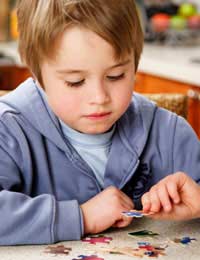Small Muscle Control

Muscle control is an individual’s ability to control and direct their muscle movements, therefore small muscle control is an individual’s ability to control and direct their small muscle movements. Sometimes small muscle control is also referred to as fine muscle control. For the most part, small/fine muscles are those in the hands and fingers. Below are answers to some frequently asked questions about children and small muscle control.
Why Is Small Muscle Control Important?
Small muscle control is important because there are many everyday tasks that require dexterity. Writing, cutting, and tying shoe laces are just a few of the activities that require small muscle control. Without small muscle control modern living would be difficult.Which Activities Require Small Muscle Control?
Many activities require small muscle control to be completed successfully. Writing, cutting and tying shoe laces have already been mentioned, but typing, using a knife and fork, colouring, folding paper, using game controls and even doodling all require small muscle control as well. Cooking and sewing are also areas in which small muscle control is important too.How Is Small Muscle Control Developed?
Small muscle control can be developed by practice. For example, the more a child writes his or her name the more confident (s)he will become in forming the letters and writing legible. In the same vein, the more a child ties his or her shoe laces the more skilled (s)he will become at making loops and knots. The same goes for any activity that requires small muscle control – the more the activity is practiced, the greater small muscle control will be.Is Small Muscle Control Affected By Handedness?
Handedness, or whether a child shows more comfort using their left or right hand, does not necessarily affect small muscle control other than in the sense that the hand that is favoured usually develops greater small muscle control than the one that is not used as often. Children sometimes show a preference for a certain hand as early as age two, though by school age the preferred hand will be more easily recognised and consistent. Some children never show a preference for one hand and continue to develop the small muscles in both hands relatively equally. Such children are said to be ambidextrous.How Can Small Muscle Control Be Encouraged?
Small muscle control can be encouraged both through practice of particular activities as well as throughout smaller toys that require manipulation by the child. For example, playing with Legos requires a child’s hands to grasp, twist and push the pieces, among other things. Construction sets, puzzles and miniatures all require similar actions from the child involved. Snapping snaps, fitting buttons, playing with zippers, and lacing laces also encourage small muscle control in children.What About Children Lacking Small Muscle Control?
There is no standard which children must meet in order to be “good” at controlling their small muscles. In fact, it is often not until they go to nursery or school that children truly begin to make advances in developing their small muscle control. However, if it is feared that children are lacking small muscle control then discussing the issue with the child’s doctor or teacher is a good idea.
Related Articles in the 'Physical Development 3+' Category...
My 30 month old toddler shows remarkable skills in small muscle development. In fact, she does not fill the page as other children do. What does this mean?
None - 15-Jan @ 1:21 AM
Wanting to know about the Childrens Small Muscle Developement.
Oneka - 23-Mar @ 4:51 PM


Re: Speech Therapy for Children
Dear Speech Therapy Clinic, I am writing to inquire about speech therapy services for my 3-year-old son. I have noticed that he…
Re: Child Temper Tantrums
I often use my book center for a calm down center. It is not a punishment but a place to take a break and calm down quietly
Re: Mahler's Theory of Development
I'm learning a lot about the end theories .
Re: Child Temper Tantrums
As an assistant director, I get brought kids who the teachers are struggling with to help calm them down. I bring them into my office, we…
Re: Brain Development in Young Children
Hi I have a son. He is 2 and half years old and he is diagnosed with autism. He doesn’t respond to his name and appears…
Re: Child Temper Tantrums
i think once you start to learn the child handling their behavior is easier. it takes time but patience is a virtue!
Re: Erikson's Theory of Psychosocial Development
No, children develop in their own pace for example, a 1-year-old would develop to hold a pencil and another…
Re: Extra Tutoring: How Do I Pay?
i am looking to help out students with private tuition as their parents cant afford it i would like to apply for grants or…
Re: The 'Terrible Twos'
child throws temper tantrum when its cleanup time even when singing the cleanup song, hits my hand and starts pulling the toys back out of the…
Re: Child Temper Tantrums
we work with 5 year olds to 12 year olds.We try to tell the kids what are the basic rules the first day of school.We call them friends from…